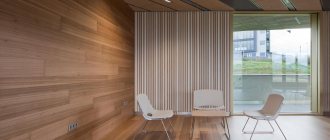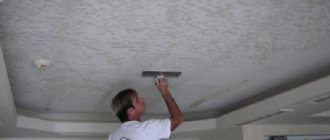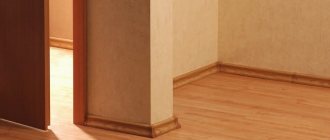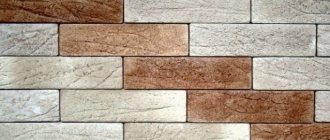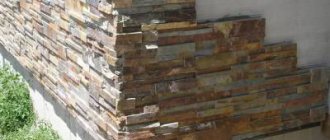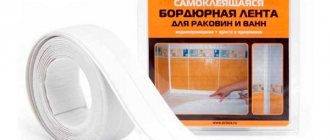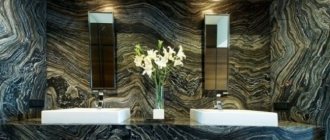The gypsum board itself (plasterboard sheet) is the result of the genius of human thought. It’s difficult to put into words how much it speeds up and facilitates the process of finishing the premises. This material, durable and reliable, always perfectly smooth and easy to use, rightfully occupies first place in the finishing materials market.
Drywall is successfully used for leveling surfaces, creating unusual arches, multi-level ceilings, partitions, full partitions between rooms, decorative niches and other works.
In order to work with this material, you don’t need to be a genius; it is simple and easy to use, and components such as, for example, sealing tape for gypsum plasterboard profiles and slab joints, special profiles and connectors make working with it convenient , and the result is impressive in its accuracy. Not to mention the huge financial benefits, if you compare the leveling of walls with gypsum board and plaster - the first is always cheaper, and the result, as a rule, cannot be distinguished from the outside. There is only one thing that gives drywall indoors: always perfectly flat surfaces, as if drawn with a ruler.
One of the necessary materials for the work is a special tape, which is used to effectively insulate frame elements, as well as tape for sealing joints of gypsum board slabs. Let's talk about them in detail.
Kinds
Not all beginners know that when installing gypsum boards, in addition to profiles and other frame elements, they use tapes that improve the quality of finishing. Moreover, they come in several types:
Types of strips for gypsum boards
Sealing
Sealing or damping tape is usually made of foamed polyethylene or other porous material. Its back side is covered with an adhesive composition, onto which a protective strip is glued. In other words, this material is self-adhesive.
As a result, it is easily glued to the back of the profiles. In addition, the seal can be glued to the back of the hangers.
The photo shows a seal for profiles, which is a foamed self-adhesive strip
Purpose. So, we figured out what a sealing tape for a profile is, but why is it needed? Since the seal is located between the base (wall or ceiling) and the profile, it performs several quite important functions at once:
- Dampens vibrations. As a result, the likelihood of cracks appearing on the surface of the plasterboard is reduced;
- Dampenes impact noise. This property is especially important when covering interfloor ceilings with plasterboard;
- Elimination of irregularities. The sealant allows you to level out unevenness in walls and ceilings.
It must be said that the seal is not a mandatory element. Therefore, very often craftsmen assemble frames for drywall without it. However, as you can see, the use of this material is highly desirable.
The seal is easily glued to the back side of the profile
Apply. The seal is glued to all elements that are in contact with the base, i.e. on guide profiles and hangers. The process of installing it yourself is extremely simple - you just need to tear off the protective strip and press the material onto the surface of the profile. The latter must be clean.
Price:
| Brand | Price in rubles |
| Knauf 9.5 cm x 30 m | 380 |
| "SK Trading" 50 mm * 30 m | 157 |
| Stels Dichtungsband 95 mm x30m | 245 |
The prices in the table and below are relevant in the summer of 2021.
The reinforcing strip allows you to avoid the appearance of putty cracks at the joints of gypsum boards
Reinforcing
Reinforcing tape for drywall is used when sealing seams. Its main task is to prevent cracking of the putty. Unlike all other tapes for gypsum boards, reinforcing ones can be called truly necessary.
It should be noted that there are several types of seam sealing strips:
- Paper. The main feature is that it is thin and has a uniform structure with the surface of the gypsum board. As a result, it is easily glued to the joint using putty. It must be said that the paper strip can be solid or perforated. Essentially, it doesn't matter what the surface is;
Serpyanka has high tensile strength
- Mesh. Mesh tape, or simply serpyanka, is made from fiberglass. An adhesive composition is applied to its back side, making the mesh self-adhesive. Another advantage of the material is its high tensile strength;
- Non-woven. Has the greatest strength. It is glued using the same principle as a paper strip. Since its thickness is greater, when finishing gypsum board, a thicker layer of putty is required.
Non-woven tape for drywall is highly resistant to various mechanical loads
Application. Instructions for sealing seams are as follows:
| Illustrations | Description of actions |
| Preparation of seams. If the edges of the sheets are even, you need to cut chamfers 5-8 mm wide. | |
Reinforcement of seams with serpyanka. If self-adhesive tape is used to seal seams, then the work is performed as follows:
Before you begin reinforcing the seams, be sure to prime the surface of the gypsum board. | |
Reinforcement of seams with tape. If paper or non-woven tape is used for joints, the work is performed slightly differently:
To properly fill a joint with putty, apply the compound with a spatula across the joint. A thin layer of putty is applied over the strip and leveled with a spatula. |
Price:
| Brand | Cost in rubles |
| Mega (serpyanka) 50 mmx90m | 50 |
| Knauf (non-woven fabric) 50 mmx150m | 190 |
| MDSU (paper) 38 mmx40m | 70 |
| Sheetrock (paper) 50 mmx22.8 m | 95 |
For separation
The dividing strip is designed to create a sliding joint between drywall and building elements (walls, ceilings, etc.). This allows you to avoid the appearance of cracks in the abutment areas and other surfaces of the plasterboard. The use of dividing strips is recommended in houses with large shrinkage.
The dividing strip is glued between the edge of the gypsum board and the structural element of the building
It must be said that in practice these bands are used very rarely. Therefore, they are quite difficult to find on sale.
Application: The dividing strip is self-adhesive. It is glued between the edge of the sheet and the main wall or ceiling, as shown in the diagram above.
Price. Dividing strips are produced by the Knauf company. The cost of one roll 60 mm wide and 50 m long is about 900 rubles.
How to use soundproofing tapes
If a product with an adhesive base is used for vibration isolation, then using the material is quite simple. From the outer part of the surface you need to remove the protective film, which allows the material not to stick together. The side with the adhesive base is applied to the wall surface or metal profile.
In the case where an insulating lining without an adhesive layer is used, glue is applied to the wall surface, in the form of liquid nails or sealant. A frame is mounted to the fixed vibration pad. You can also press the tape with the profile and not use glue for fixation. When the pad is installed under the frame, you don't have to worry about vibration, as it will be absorbed by the porous structure.
Characteristics of soundproofing tape
To protect metal frames from noise, when constructing ceilings and walls, and laying floor coverings, damper tape is used. The rolled material is 30 m long, 10 cm wide and 3 mm thick. Surface density: 300 g/m2. The adhesive layer is applied to one or both sides of the tape.
The soundproofing gasket Vibrostek-M has the following characteristics:
- Correspondence between price and material efficiency.
- Reliable protection against structural noise, despite its small thickness.
- Long service life.
- Resistant to various intense loads.
Vibration-isolating tapes are in demand in the construction of residential buildings and office premises. With Vibrostek-M, rooms become more comfortable to stay in. The tapes are mounted between special materials. This ensures high-quality acoustics.
Tape sound insulation is not subject to deformation even under the influence of external factors and phenomena. The material has a number of characteristics:
- Zero water absorption.
- Resistant to oxidation, ultraviolet radiation, alkalis and weak acids.
- Elasticity and softness.
- Light weight (1 kg).
Vibroacoustic characteristics of the Vibrostek-M tape: dynamic modulus of elasticity 0.18 MPa at a load of 2 kPa; at 5 kPa - 0.35.
Possible applications of Vibrostek-M
Soundproofing tape is used as a cushioning material when installing:
- ZIPS panel system in building structures.
- Wooden floors and floors.
- Frame soundproofing cladding and partitions.
When installing sandwich panels, the tape is laid in two layers at the points of contact with the ceiling and side walls, at points of support on the floor. When installing frame partitions, sound insulation is placed between the fastening elements and load-bearing building structures, at the junction of the partition sheathing sheets.
Vibrostek-M is used when arranging wooden floors. The material is placed under the joists and floor beams - at the points of their support on the walls. The width of the tape should be more than 10mm on each side of the beam or joist. The vibration stack is also laid on the ends of the beams that rest on the walls.
The soundproofing gasket Vibrostek-M is indispensable:
- When assembling various sound insulation systems (with and without frame).
- In cladding and wall structures.
- When installing suspended ceilings.
The tape is used as a border layer in the manufacture of a floating floor.
Sealing tape
Sealing substrates are made of elastic polyethylene foam. These are cellular strips covered with a self-adhesive layer on one side. They are protected by special paper, which is peeled off before use. The form of release of sealing strips is rolls of various lengths.
The material differs in brand, length and thickness of polyethylene foam. There are 3 varieties:
- Uncrosslinked gas-filled.
- Chemically cross-linked.
- Physically stitched.
The width of the tape varies from 30 to 90mm. Common thickness is 30mm.
Sealing gaskets ensure a tight joint between the metal profile for plasterboard, as well as load-bearing structures - walls and floors. The tape is used not only for sealing, but also for vibration reduction and sound insulation.
Reference. A plasterboard partition made of sealing gaskets will serve not only as protection from noise, but also as a screen, attracting and amplifying vibrations and sounds from neighboring rooms.
The material is glued onto guides through which sounds pass from one room to another. Rack profiles fixed to the walls are also covered with insulating tape.
Reinforcing tape
Reinforcing tape is indispensable when performing various construction works - repairing walls and ceilings, preventing the formation of cracks at the joints of plasterboard slabs, shedding, swelling, peeling of the cladding. The structure of the tape contains intertwined fibers of strong material. The products are produced in reels, 50-100 meters long. Regular and self-adhesive material is available for sale.
Self-adhesive tape serves as an excellent electrical insulating material. It is used for waterproofing pipes and caulking joints. Serpyanka is intended for reinforcing seams when performing finishing work.
Ordinary paper tape is used to seal simple seams. Compared to serpyanka, paper reinforcement tape has significant advantages:
- An excellent combination with drywall and putty.
- Possibility of use when strengthening the prepared surface due to its minimal thickness.
- Reasonable price.
The reinforcing tape is attached using putty or gypsum plaster. Fabric and paper are characterized by good moisture absorption. PVC tape is moisture resistant.
Important! When covering drywall, the use of reinforcing tape is mandatory. This will ensure the strength of the structure and protect it from external influences.
Separating sealing tape is used in houses subject to severe shrinkage. The material plays a primary role in sealing the joints of plasterboard sheets. During construction and repair work, dividing tape is a component material for gypsum boards along with jumpers, profiles, screws, etc.
A tape separation gasket is required to perform a number of jobs:
- Metal profile fastenings.
- Tightly seal seams between sheets.
- Fixing mounted partitions to ceilings and load-bearing walls.
The dividing tape is produced in rolls, the thickness of which is from 2 to 4 mm, the length is from 30 m.
For effective sound insulation, Vibrostek-M materials are used. Due to the elastic properties of fiberglass and air pores, vibration isolation tape has unique damping characteristics.
Sealing tape for drywall profiles is a special material used when creating a metal frame for drywall, as well as when sealing gypsum board joints. It has its own varieties and distinctive properties.
Sealing damper tape is a sound insulator and vibration absorber
Areas of application of vibration damping tapes
Due to its properties, soundproofing tape dampens vibrations of metal structural elements. The products contain rubber and foamed polyethylene. In this regard, the scope of application is quite wide. The material is used in the manufacture of metal structures on all working surfaces of the room: ceiling, floor and walls. When constructing a frame from a metal profile, noise insulation tape allows you to minimize vibration vibrations, thereby providing reliable noise and heat insulation.
@Lenta
Characteristics of sealing damper tape
This type is made from polyethylene foam material. On one side there is a sticky layer for gluing. It is easily applied to metal elements used to create a frame for drywall and is firmly fixed. This tape has advantages:
Damper sealing tape for metal profiles under plasterboard
- is a noise absorber;
- When using tape during installation, the metal profile does not come into contact with the concrete base, which prevents the occurrence of condensation and oxidation;
- absorption of vibration arising from neighbors above or from construction (other) work on the street.
If vibration of structures occurs, the use of the material prevents cracks from appearing on the drywall.
Watch the video: using sealing tape.
Sealant is not always used when working with drywall, but it is advisable to use it.
Application
By following the correct technology for using a damper seal in repair work, it will create additional protection for the plasterboard structure from harmful influences.
The sealing material should be glued to the side of the mounted profiles to the rough surface. For convenience, you should have a cutting knife on hand. Since the tape has a layer of glue, it is quite easy to fix it on the profile.
The cost on the construction market ranges from 157 rubles. up to 400 rub. per roll.
Application of damper tape under the guide profile
Working with sealing material
Some craftsmen who do apartment renovations on their own believe that they can do without tape. But it is necessary for proper fastening of the drywall profile and compliance with the technology. It should be remembered that the profile tape adheres best at a temperature of +10 degrees. It is advisable that after completion of work the temperature remains the same for another 1–2 days.
Working with self-adhesive tape is very simple. You need to choose a material that suits your characteristics and width. After you have marked the profiles and cut them, you need to degrease them, remove the protective paper from the sealing strip and stick it on. After this, you can attach the metal profiles to the walls.
Characteristics of reinforcing tape
Reinforcing tape is a specially created material for strengthening drywall joints. It performs the important function of fastening gypsum board joints, which gives a durable structure. Subsequently, there are no cracks or deformations of the ceiling or plasterboard walls. There are several types of reinforced tape:
- Serpyanka is a self-adhesive reinforcing tape with a composition similar to a synthetic bandage. Used to seal joints in plasterboard sheets;
Serpyanka is available in various sizes for plasterboard joints - perforated paper - used manufactured by KNAUF, distinguished by its strength and quality of functions. Thanks to the perforation, the tape does not gather like an accordion during installation, air bubbles do not collect under it, and has excellent air-permeability properties, which is important for a plasterboard product;
Knauf paper tape is a durable material for reinforcing drywall joints - bandage - is a durable fiberglass material made from non-woven fabric. It is attached with a “raw” putty solution to the joints. Has the same properties as serpyanka.
Non-woven sealing tape for reinforcing drywall joints will create the strength of the entire structure due to its composition
The use of reinforcing tape is mandatory when finishing drywall, since it strengthens the created structure and prevents further impacts on the structure.
The installation of reinforcing material is required depending on its type. Self-adhesive is applied and fixed easier than paper or non-woven tape.
Watch the video: laying reinforcing tape at a gypsum board joint.
Installation of KNAUF paper is carried out in stages:
- preparation of joints - it is required that the plasterboard joints have a chamfer. If it is not there, then you should use a construction knife to carefully make cuts on the edges of the drywall at 45 degrees, 5 mm deep;
- chamfered joints should be cleaned of dust and plaster stones;
- Using a brush, cover the seam well and thoroughly with the primer mixture. Let dry;
- after this, the Knauf Uniflot putty solution is diluted (considered by the masters to be one of the best mixtures), according to the table on the bag;
- Cover the seam with a thin layer of putty. A paper tape is applied evenly to the wet putty and pressed with a spatula so that the edges are firmly fixed in the putty. Excess solution comes out and remains on the spatula. They can be used to seal fasteners.
Filling fasteners with putty to reinforce joints - After drying, the tape should be covered with a second layer of putty. When dry, remove all excess pieces from the finished joint with sandpaper.
The cheapest of this series is the serpyanka - the price is 50 rubles, the most expensive - the Knauf non-woven one costs 190 rubles. Paper tape can be bought for 70 and 95 rubles.


